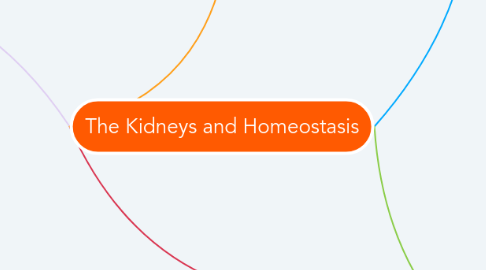
1. Blood Pressure Control
2. ↓ Blood Pressure
3. Renin in Kidney released
4. Angiotensin I
5. ACE (Angiotensin Converting Enzyme
6. Angiotensin II
7. Angiotensin II acts directly to the blood vessels, causing Vasoconstriction
8. ↑ Blood Pressure
9. Acid - Base Balance
9.1. H20 + CO2→ H2CO3 → HCO3 + H
9.1.1. 1. The filtered Bicarbonate ion undergoes a reaction sequence to produce water and carbon dioxide
9.1.2. 2. The water and carbon dioxide molecules diffuse into the proximal tubule cell and undergo the same reaction sequence in reverse to reform the bicarbonate ion. The resulting hydrogen ion is secreted back into the lumen
9.1.3. 3. The bicarbonate ion diffuses into the blood.
10. FALL IN PLASMA pH = ↑ Hydrogen ions
11. Drive the bicarbonate sequence to the LEFT to produce CO2 and water
12. ↑ Plasma pH
13. RISE IN PLASMA pH = ↓ Hydrogen Ions
14. The kidney reduces the amount of hydrogen ion secretion → results in a reduction in the plasma bicarbonate level.
15. The plasma bicarbonate concentration corrected by a reduction in ventilation rate by the lungs → build up of CO2, which drives the reaction sequence to the RIGHT to generate more bicarbonate ions
16. ↓ Plasma pH
17. Maintenance of Normal Red Blood Cell Count
18. Erythropoietin production in the kidney is stimulated by hypoxia and inhibited when hypoxia is corrected. Erythropoietin is a glycoprotein that promotes the proliferation and differentiation of erythrocyte precursors on the bone marrow making them essential in the maintenance of a normal red cell count
19. Secretion of Aldosterone is stimulated which stimulates reabsorption of Sodium and water
20. Body Fluid Volume and Osmolality
20.1. ADH (Antidiuretic Hormone)
20.1.1. 1. Change in Plasma Osmolality
20.1.2. 2. HYPOTHALAMUS → detects small changes in the plasma osmolality
20.1.3. 3. POSTERIOR PITUITARY → secrete ADH.
20.1.3.1. ↑ Plasma Osmolality = ↑ secretion of ADH
20.1.3.2. ↓ Plasma Osmolality = ↓ secretion of ADH
20.2. ALDOSTERONE
20.2.1. Via RAAS system, Aldosterone stimulates In kidneys, more sodium and water return to blood and more potassium eliminated in urine
20.2.1.1. ↑ Blood Volume
20.3. Atrial Natriuretic Hormone
20.3.1. Inhibition of aldosterone by the adrenal cortex
20.3.2. Reduction of renin release by the Kidney
20.3.3. Reduction of ADH release from the Posterior Pituitary
20.3.4. Vasodilation
20.3.5. Natriuresis and Diuresis
20.3.6. Results in the excretion of sodium and water through the kidneys reducing the extracellular fluid back to normal
21. Electrolyte Balance
21.1. SODIUM
21.1.1. ↓ Sodium levels
21.1.1.1. ALDOSTERONE via RAAS system increases sodium and water retention.
21.2. POTASSIUM
21.2.1. ↑ Potassium Levels
21.2.1.1. Stimulates ALDOSTERONE secretion
21.2.1.1.1. ↑ secretion of potassium into the urine
21.2.2. ↓ Aldosterone
21.2.2.1. Reverse occurs and less potassium is secreted into the urine
21.3. CALCIUM
21.3.1. 1. ↓ Calcium is detected by cells of the parathyroid glands
21.3.2. 2. Parathyroid glands ↑ release of parathyroid hormone (PTH) which circulated in the blood
21.3.3. 3. PTH binds to receptors on the distal tubules and on bone
21.3.4. 4. Kidney → ↑ Calcium reabsorption and ↓ phosphate reabsorption Activation of vitamin D → ↑ intestinal absorption of calcium Bone → increased bone resorption
21.3.5. 5. The resulting increase in calcium reduces the stimulation of the parathyroid glands
21.4. MAGNESIUM
21.4.1. ↓ Magnesium levels
21.4.1.1. ↑ Efficiency of magnesium reabsorption in the kidneys from filtrate
21.4.1.1.1. ↑ magnesium reabsorption = ↓ magnesium loss in the urine
21.4.2. ↑ Magnesium levels
21.4.2.1. Kidneys exceed capacity to reabsorb Magnesium from filtrate
21.4.2.1.1. ↑ Magnesium remain in the filtrate and are eliminated in the urine
